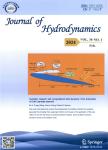Numerical study of the acoustic spectrum of bubble clusters
作者机构:Zhejiang Univ Dept Engn Mech State Key Lab Fluid Power & Mechatron Syst Hangzhou 310027 Peoples R China
出 版 物:《JOURNAL OF HYDRODYNAMICS》 (水动力学研究与进展B辑(英文版))
年 卷 期:2024年第36卷第4期
页 面:637-649页
核心收录:
学科分类:080704[工学-流体机械及工程] 080103[工学-流体力学] 08[工学] 0807[工学-动力工程及工程热物理] 0801[工学-力学(可授工学、理学学位)]
基 金:National Natural Science Foundation of China State Key Program of National Natural Science of China
主 题:Bubble cluster cavitation noise acoustic spectrum Ffowcs Williams-Hawkings (FW-H) method NOISE PREDICTION SIMULATION HYDROFOIL COLLAPSE FLOW
摘 要:This study delved into the acoustic spectrum of bubble clusters, each consisting of 352 vapor bubbles across volume fractions ranging from 0.005% to 40%. The clusters, organized in five distinct layers, were modeled using the volume of fluid (VOF) method to capture the bubble interfaces, and the Ffowcs Williams-Hawkings (FW-H) methodology to compute the far-field acoustic pressure from bubble collapse. Further analysis revealed distinct sound pressure behaviors across different volume fractions: For 25%-40%, time-domain analysis shows that the peak acoustic pressure pulses from the two innermost layers of bubbles are significantly higher than those from the outer layers. In the frequency domain, the octave decay rate of the acoustic pressure levels is relatively low, around -3dB/octave. For 0.5%-25%, four acoustic pressure pulses with similar widths and peak values were observed in the time domain. In the frequency domain, there are three distinct peaks in sound pressure levels (SPL), directly linked to the difference in collapse times of bubbles within the cluster, and the octave decay rate accelerates as the volume fraction decreases, stabilizing at -6dB/octave when the volume fraction is reduced to 17.5%. For 0.005%-0.5%, as the volume fraction decreases from 0.5% to 0.1%, the number of acoustic pressure pulses significantly reduces. Below 0.1% volume fraction, only a single wider pulse is observed. In the frequency domain, the octave decay rate gradually increases with decreasing volume fraction, significantly exceeding -10dB/octave when it drops below 0.1%, reaching up to -11.7dB/octave.



